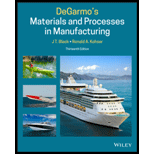
Concept explainers
What enables us to control the properties and performance of engineering materials?
The feature controlling the properties and performance of engineering materials.
Explanation of Solution
The feature that controls the properties and performance of engineering materials is the structure of the material.
The properties possessed by a material depends on the microstructure of the material. To impart certain properties, the structure of the material becomes focus of study. The material structure is designed and produced according to the requirement of the properties desirable in the final product.
If it is required to change the properties of the material or change the performance of the material in order to employ the material for getting maximum performance output, the one thing which can be focussed first is the structure of the material. If the material in hand is supposed to be not working adequately then an advanced version of the same material can be prepared by just tweaking the structure of the material.
Thus, the properties and performance of engineering materials are controlled by the structure of the material.
Want to see more full solutions like this?
Chapter 3 Solutions
Degarmo's Materials And Processes In Manufacturing
- On engineering materials, which has longer life, short belt or long belt? And why?arrow_forwardWhich factors affect the mechanical properties of a material under applied loads?arrow_forwardA person looking for material which is neither conduct nor insulate electricity, which type of materials you would recommend. State one example, one application and other characteristic of that materials?arrow_forward
- The understanding and modification of the structure and properties of materials to improve the performance and processing of the material is calledarrow_forwardQ1/ On what basis are the materials properties categorized? Give typical examples.arrow_forwardWhat is the relationship between structure and Mechanical properties of a material?arrow_forward
- Define engineering materials. Your definition should emphasize theiruse/application in engineering works.arrow_forwardEngineering materials plays an important role in manufacturing industry for the development of products for high performance applications. Describe the main classifications of engineering materials and give details of physical and mechanical properties of three materials for each category.arrow_forwardWhy is the theoretical strength of materials higher than the observed strength?arrow_forward
 Elements Of ElectromagneticsMechanical EngineeringISBN:9780190698614Author:Sadiku, Matthew N. O.Publisher:Oxford University Press
Elements Of ElectromagneticsMechanical EngineeringISBN:9780190698614Author:Sadiku, Matthew N. O.Publisher:Oxford University Press Mechanics of Materials (10th Edition)Mechanical EngineeringISBN:9780134319650Author:Russell C. HibbelerPublisher:PEARSON
Mechanics of Materials (10th Edition)Mechanical EngineeringISBN:9780134319650Author:Russell C. HibbelerPublisher:PEARSON Thermodynamics: An Engineering ApproachMechanical EngineeringISBN:9781259822674Author:Yunus A. Cengel Dr., Michael A. BolesPublisher:McGraw-Hill Education
Thermodynamics: An Engineering ApproachMechanical EngineeringISBN:9781259822674Author:Yunus A. Cengel Dr., Michael A. BolesPublisher:McGraw-Hill Education Control Systems EngineeringMechanical EngineeringISBN:9781118170519Author:Norman S. NisePublisher:WILEY
Control Systems EngineeringMechanical EngineeringISBN:9781118170519Author:Norman S. NisePublisher:WILEY Mechanics of Materials (MindTap Course List)Mechanical EngineeringISBN:9781337093347Author:Barry J. Goodno, James M. GerePublisher:Cengage Learning
Mechanics of Materials (MindTap Course List)Mechanical EngineeringISBN:9781337093347Author:Barry J. Goodno, James M. GerePublisher:Cengage Learning Engineering Mechanics: StaticsMechanical EngineeringISBN:9781118807330Author:James L. Meriam, L. G. Kraige, J. N. BoltonPublisher:WILEY
Engineering Mechanics: StaticsMechanical EngineeringISBN:9781118807330Author:James L. Meriam, L. G. Kraige, J. N. BoltonPublisher:WILEY





